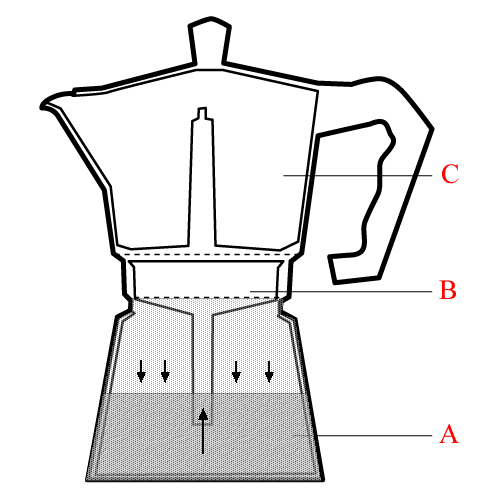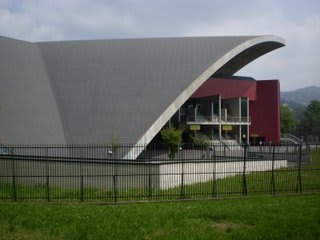Today I would like to speak about a different subject: coffee and Italian coffee machines. Before the second world war, there were many kinds of coffee makers in Italy. But of all these, the "Napoletana" coffee maker, invented in Napoli around 1840, became common all over Italy and was found everywhere.
In 1933, a new coffee maker was invented in Torino: it is called Moka and was invented by a company based near Torino called Bialetti. After being invented it gradually came to be the most common, but took a lot of time to (almost) completely supplant the "Napoletana". And lately,from the '80s, expresso machines which make Italian coffee "like in the bar" are becoming more and more common and many families have one.

Anyway, since the moka is still the most common maker in Italian homes, I will speak about it first. It is composed of three parts: a boiler which contains water. A filter in which coffee is put. And a container which is put over the filter. The maker is made in a way such the when the water boils, it goes up and passes through the filter, and then still up until it erupts in the container. The maker works with the pressure of hot water, and when the water starts filling up the container, it makes a characteristic gurgling noise.
The "Napoletana" maker works in a completely different way. There is a boiler, like in the Moka. There is a filter too, and the coffee has to be put inside the filter. And there is a container where coffee will go. But it does not work with pressure. When the water is boiling, some of it starts dripping out of a small hole. Then, it is time to take the maker, and turn it upside down. Now, slowly, the hot water will come down and seep through the coffee, then drip down in the container, ready to be poured in Italian coffee cups.
Now, comparing the two ways of making coffee: coffee made with the Moka is a little bitter and a little stronger, because the water is hotter when it meets the coffee. On the other hand, coffee made with the Napoletana is lighter, sweeter, but has maybe more taste, because while the water is less hot, it takes more time to seep through the coffee. Comparing the taste of Napoletana coffee to Japanese coffee, the Napoletana one is stronger than the Japanese one, but not as strong as the Moka or espresso.
Now, I am a kind of Torino localist and almost a "nationalist" for my city. But I am also in love with old traditions. In my parent's home, we always used the moka machine, but I always saw an old Napoletana maker tucked away inside a drawer. So when I went to live alone for the first time, some years ago, I went to a supermarket and bought a Napoletana coffee maker. I was lucky to find it, because now, Napoletana makers are harder and harder to find. There are some companies which still make it, and I have the impression that there will be a "napoletana renaissance" someday: because they are becoming things of the tradition and of the past, and so things in need of being recovered. There are some wonderful "new" models of Napoletana made by Alessi, for example. But one thing is sure: it is now impossible, after just a few years, to find a Napoletana coffee maker in a supermarket. But I still have the one I bought and that is the one we use every morning to make coffee.
In 1933, a new coffee maker was invented in Torino: it is called Moka and was invented by a company based near Torino called Bialetti. After being invented it gradually came to be the most common, but took a lot of time to (almost) completely supplant the "Napoletana". And lately,from the '80s, expresso machines which make Italian coffee "like in the bar" are becoming more and more common and many families have one.

Anyway, since the moka is still the most common maker in Italian homes, I will speak about it first. It is composed of three parts: a boiler which contains water. A filter in which coffee is put. And a container which is put over the filter. The maker is made in a way such the when the water boils, it goes up and passes through the filter, and then still up until it erupts in the container. The maker works with the pressure of hot water, and when the water starts filling up the container, it makes a characteristic gurgling noise.
The "Napoletana" maker works in a completely different way. There is a boiler, like in the Moka. There is a filter too, and the coffee has to be put inside the filter. And there is a container where coffee will go. But it does not work with pressure. When the water is boiling, some of it starts dripping out of a small hole. Then, it is time to take the maker, and turn it upside down. Now, slowly, the hot water will come down and seep through the coffee, then drip down in the container, ready to be poured in Italian coffee cups.
Now, comparing the two ways of making coffee: coffee made with the Moka is a little bitter and a little stronger, because the water is hotter when it meets the coffee. On the other hand, coffee made with the Napoletana is lighter, sweeter, but has maybe more taste, because while the water is less hot, it takes more time to seep through the coffee. Comparing the taste of Napoletana coffee to Japanese coffee, the Napoletana one is stronger than the Japanese one, but not as strong as the Moka or espresso.
Now, I am a kind of Torino localist and almost a "nationalist" for my city. But I am also in love with old traditions. In my parent's home, we always used the moka machine, but I always saw an old Napoletana maker tucked away inside a drawer. So when I went to live alone for the first time, some years ago, I went to a supermarket and bought a Napoletana coffee maker. I was lucky to find it, because now, Napoletana makers are harder and harder to find. There are some companies which still make it, and I have the impression that there will be a "napoletana renaissance" someday: because they are becoming things of the tradition and of the past, and so things in need of being recovered. There are some wonderful "new" models of Napoletana made by Alessi, for example. But one thing is sure: it is now impossible, after just a few years, to find a Napoletana coffee maker in a supermarket. But I still have the one I bought and that is the one we use every morning to make coffee.


















 四月の魚のいたずらだったらよかったのにと買わずに店を後にしました。
四月の魚のいたずらだったらよかったのにと買わずに店を後にしました。